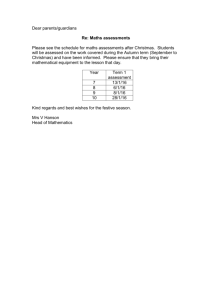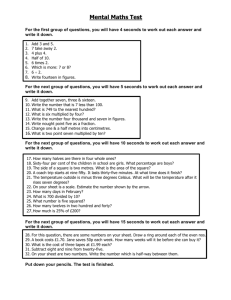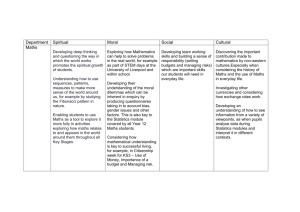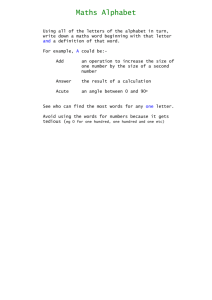Probability - Nayland Maths
advertisement
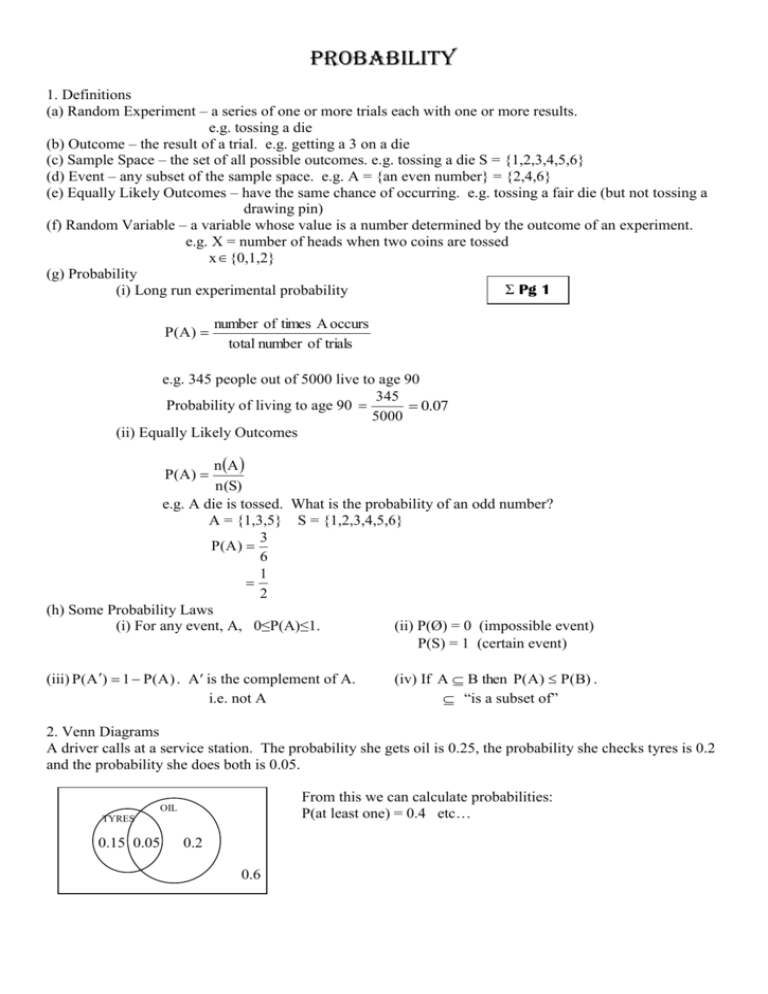
Probability
1. Definitions
(a) Random Experiment – a series of one or more trials each with one or more results.
e.g. tossing a die
(b) Outcome – the result of a trial. e.g. getting a 3 on a die
(c) Sample Space – the set of all possible outcomes. e.g. tossing a die S = {1,2,3,4,5,6}
(d) Event – any subset of the sample space. e.g. A = {an even number} = {2,4,6}
(e) Equally Likely Outcomes – have the same chance of occurring. e.g. tossing a fair die (but not tossing a
drawing pin)
(f) Random Variable – a variable whose value is a number determined by the outcome of an experiment.
e.g. X = number of heads when two coins are tossed
x {0,1,2}
(g) Probability
Σ Pg 1
(i) Long run experimental probability
P(A)
number of times A occurs
total number of trials
e.g. 345 people out of 5000 live to age 90
345
Probability of living to age 90
0.07
5000
(ii) Equally Likely Outcomes
n A
n (S)
e.g. A die is tossed. What is the probability of an odd number?
A = {1,3,5} S = {1,2,3,4,5,6}
3
P(A)
6
1
2
(h) Some Probability Laws
(i) For any event, A, 0≤P(A)≤1.
(ii) P(Ø) = 0 (impossible event)
P(S) = 1 (certain event)
P( A)
(iii) P(A ) 1 P(A) . A′ is the complement of A.
i.e. not A
(iv) If A B then P(A) P(B) .
“is a subset of”
2. Venn Diagrams
A driver calls at a service station. The probability she gets oil is 0.25, the probability she checks tyres is 0.2
and the probability she does both is 0.05.
From this we can calculate probabilities:
P(at least one) = 0.4 etc…
OIL
TYRES
0.15 0.05
0.2
0.6
3. Mutually Exclusive and Addition
If A and B are two events in a finite sample space S then n(A B) = n(A) + n(B) – n(A B)
P(A B) = P(A) + P(B) – P(A B)
P(A B) = probability of either A or B occurring
e.g. A card is drawn from a pack
If A = {the card is a spade}, B = {the card is a Queen}
1 1
1
P(A B) =
4 13 52
16
=
52
A
B
Σ Pg 7
If A B = 0 then P(A B) = P(A) + P(B)
If this is the case then A and B are disjoint.
They cannot both occur and are said to be mutually exclusive events (A B) = 0
e.g. A card is drawn from a pack
If A = {the card is red}
B = {the card is a spade}
1 1
Then, P(A B) =
4 2
3
=
4
4. Independence and Multiplication
Two events are independent when the occurrence of one in no way affects the occurrence of the other.
A and B are independent P(A B) = P(A)P(B)
P(A B) = probability of both A and B occurring
e.g. Box A contains 8 items of which 3 are defective.
Box B contains 5 items of which 2 are defective.
An item is drawn from each box.
The events are independent.
3 2
P(Drawing 2 defective items) =
8 5
3
=
20
Σ Pg 7
e.g. In a school the probability of a student failing Maths is 0.2 and failing English is 0.15 and failing both is
0.09. Are the events failing English and failing Maths independent?
Let A = {Failing Maths} B = {Failing English}, then P(A B) = 0.09
P(A B) P(A)P(B). Therefore the events are dependent.
5. Tree Diagrams
Example: sampling with replacement
An urn contains 10 marbles of which 6 are green and 4 are red. If a sample of 3 is drawn with replacement
what is the probability that 2 are green?
G
GGG
G
GGR
G
GRG
6/10
G
4/10
Σ Pg 10
6/10
G
4/10
6/10
6/10
G
4/10
G
GRR
G
RGG
G
RGR
G
RRG
G
RRR
6/10
4/10
G
4/10
6/10
R
4/10
G
6/10
4/10
6 6 4
= 0.144
10 10 10
6 4 6
P(GRG) =
= 0.144
10 10 10
P(2 green marbles) = 0.144 + 0.144 + 0.144
= 0.432
Example: sampling without replacement
Yachtperson Sally has ten tins of food all of which lost their labels in a storm. She knows that six contain
sweet corn and four contain peaches. What is the probability that if she selects three tins, two will contain
sweet corn?
P(GGR) =
S
SSS
P
SSP
S
SPS
4/8
S
4/8
5/9
S
4/9
5/8
6/10
P
3/8
P
SPP
S
PSS
P
PSP
S
PPS
P
PPP
5/8
4/10
S
3/8
6/9
P
3/9
P
6/8
2/8
6 5 4 1
10 9 8 6
6 4 5 1
P(SPS) =
10 9 8 6
P(SSP) =
P(two tins sweet corn) =
P(PSS) =
1 1 1 1
6 6 6 2
4 6 5 1
10 9 8 6
6. Conditional Probability
The probability of an event given that some other event has occurred. i.e. a reduced sample space.
It is written as PB | A - the probability of B given A.
From the tree diagram if A and B aren’t independent;
P(A B) P(A) PB | A
PB | A
Σ Pg 15
P(A B)
P( A )
E.g. Given that the toss of a die is even, what is the probability that it is divisible by three?
Method 1:
Reduced sample space is {2,4,6}
1
P(Divisible by 3 | toss is even) =
3
P(A B)
Method 2:
Using PB | A
P( A )
16
12
1
=
3
E.g. The probability that a married man watches a certain TV show is 0.4 and the probability that a married
woman watches the show is 0.5. The probability that a man watches the show given that his wife does is
0.7. Find the probability that
(i) A married couple both watch the show
(ii) A wife watches if her husband does
(iii) At least one person of a married couple watches the show
Answer
Let H = {husband watches show}
W = {wife watches show}
(i) P(H W) P(H | W) P( W)
0.5 0.7
0.35
P( H W )
P( H )
0.35
=
0 .4
= 0.875
(ii) P( W | H)
(iii) P(H W ) P(H) P( W ) P(H W )
= 0.4 + 0.5 – 0.35
= 0.55
Sometimes the use of a table can make problems easier
E.g. In an examination 20% of students sitting failed Physics, 15% failed Maths and 10% failed both. A
student is selected at random
(a) If he failed Physics what is the probability that he failed Maths?
(b) If he failed Maths what is the probability that he failed Physics?
(c) What is the probability that he failed Maths or Physics?
Answer:
Let
(a)
M = {passed Maths}
M′ = {failed Maths}
P = {passed Physics}
P′ = {failed Physics}
P(M P)
P(P)
0 .1
=
0 .2
P(M′|P′) =
= 0.5
(b)
P(M P)
P(M)
0 .1
=
0.15
P(P′|M′) =
= 0.67
(c) P(M P) P(M) P(P) P(M P)
= 0.15 + 0.2 – 0.1
= 0.25
P
P′
M
0.75
0.1
0.85
M′
0.05
0.1
0.15
0.8
0.2
1



